Kenmore 57082, 57085, 57087, 57089, 57542 Owner's Manual
...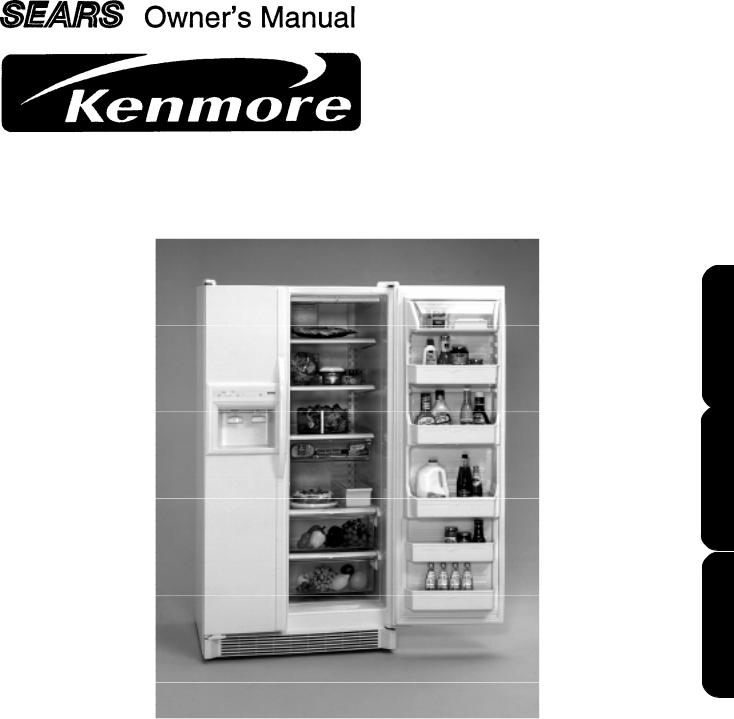
SIDE-BY-SIDE REFRIGERATOR
Model No: 57082, 57085, 57089, 57542, 57547, 57582, 57587
<![if ! IE]><![endif]>ENGLISH
<![if ! IE]><![endif]>Español
<![if ! IE]><![endif]>Français
(Model 57542 shown)
CAUTION: |
• |
Safety Instructions |
Read and follow all safety rules and |
• |
Installation Information |
operating instructions before first use of |
• |
Operating Instructions |
this product. |
• |
Care and Cleaning |
|
• |
Troubleshooting |
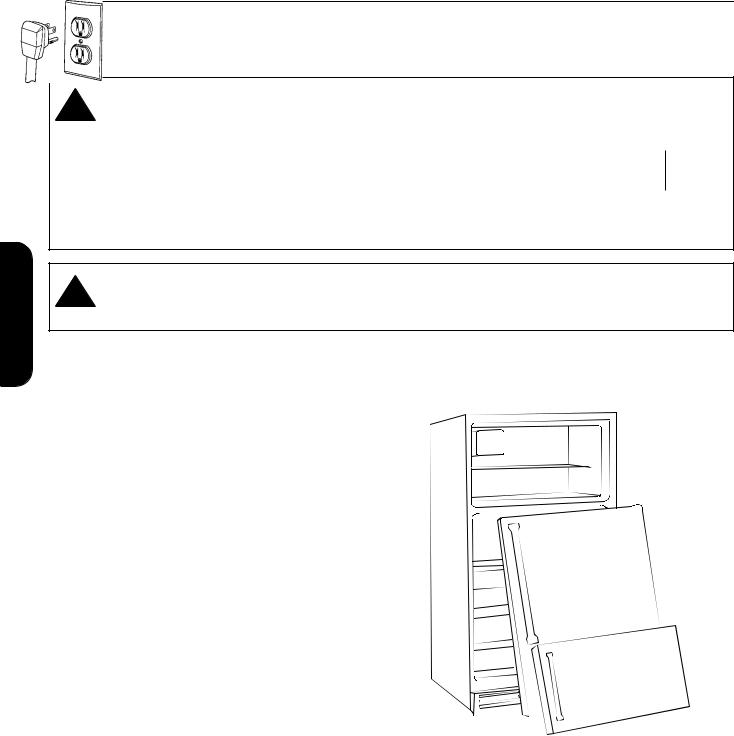
<![endif]>ENGLISH
Electrical Requirements
!Recognize this symbol as a safety precaution.
!WARNING: Electrical Grounding Instructions—This refrigerator is equipped with a three-prong (grounding) plug for protection against possible shock hazards. If you
encounter a two–prong receptacle, contact a qualified electrician and have the two-prong wall receptacle replaced with a properly grounded three-prong wall receptacle in accordance with the National Electrical Code.
Refrigerator is designed to operate on a separate 103 to 126 volt, 15 amp., 60 cycle line.
Do not under any circumstances cut or remove the round grounding prong from
the plug. Refrigerator must be grounded at all times. Do not remove warning tag from power cord.
!WARNING
Do not use a two-prong adapter. Do not use an extension cord.
Proper Disposal of Your Refrigerator
IMPORTANT: Child entrapment and suffocation are not problems of the past. Junked or abandoned refrigerators are still dangerous—even if they will sit for “just a few days”. If you discard an old refrigerator, please follow the instructions below to help prevent accidents.
BEFORE YOU THROW AWAY YOUR OLD
REFRIGERATOR OR FREEZER:
• Take off the doors.
• Leave the shelves in place so children may not easily climb inside.
2

Contents
Electrical Requirements ........................................... |
2 |
Proper Disposal of Your Refrigerator ........................ |
2 |
Installation Checklist ................................................ |
3 |
Installation Instructions |
|
Spacing Requirements ......................................... |
4 |
Leveling Refrigerator ............................................ |
4 |
Removing Handles ............................................... |
4 |
Tools Required ..................................................... |
4 |
Removing Doors................................................... |
5 |
Connecting Water Supply ..................................... |
6 |
Controls |
|
Refrigerator and Freezer Controls ........................ |
8 |
Setting Controls .................................................... |
8 |
Fresh Food Features |
|
Fresh Food Shelves.............................................. |
8 |
Temperature Controlled Meat Drawer ................... |
9 |
Crisper Drawers ................................................... |
9 |
Bottle Rack (some models) ................................ |
10 |
Covered Storage Bucket (Some models) ............ |
10 |
Dairy Center (Some models) .............................. |
10 |
Snack Shelf (Some models) ............................... |
10 |
Temperature Controlled Beverage Cooler |
|
(Some models) ................................................... |
11 |
Door Shelves ...................................................... |
11 |
Adjustable Divider (Some models) ..................... |
11 |
Freezer Features |
|
Automatic Ice Maker ........................................... |
12 |
Food Organizer Storage ..................................... |
12 |
Door Shelves ...................................................... |
13 |
Tall Package Retainer (Some models) ................ |
13 |
Ice Compartment................................................ |
13 |
Door Buckets ...................................................... |
13 |
Ice and Water Dispenser .................................... |
14 |
Care and Cleaning |
|
General Cleaning ............................................... |
15 |
Adhesives ........................................................... |
15 |
Door Gaskets ..................................................... |
15 |
Condenser Coils ................................................. |
15 |
Glass Shelves .................................................... |
16 |
Odor Removal .................................................... |
16 |
Light Bulb Replacement ..................................... |
16 |
Energy Tips ........................................................... |
17 |
Vacation Tips ......................................................... |
17 |
Normal Operating Sounds ..................................... |
18 |
Refrigerator Troubleshooting Guide ....................... |
19 |
Warranty ................................................................ |
23 |
Installation Checklist
Verify the following has been completed to ensure proper operation of your refrigerator.
Doors
•Handles are solidly attached.
•Doors seal completely to refrigerator cabinet.
•Doors are aligned squarely.
Leveling
•Refrigerator is tilted 1/4" (6 mm) higher from front to rear.
•Make sure doors are level at the top of the refrigerator doors.
•Make sure refrigerator is level from side to side and front to back.
Ice Maker
•Water supply to refrigerator is connected and turned on.
•Water leaks are not present at connection between household water supply and refrigerator. (After 24 hours check connection for water leaks.)
•Ice maker arm is in on position for ice production. (It may take up to 24 hours for first harvest of ice.)
Electrical
•Properly grounded 3-prong wall receptacle is used to plug in refrigerator.
<![endif]>ENGLISH
3
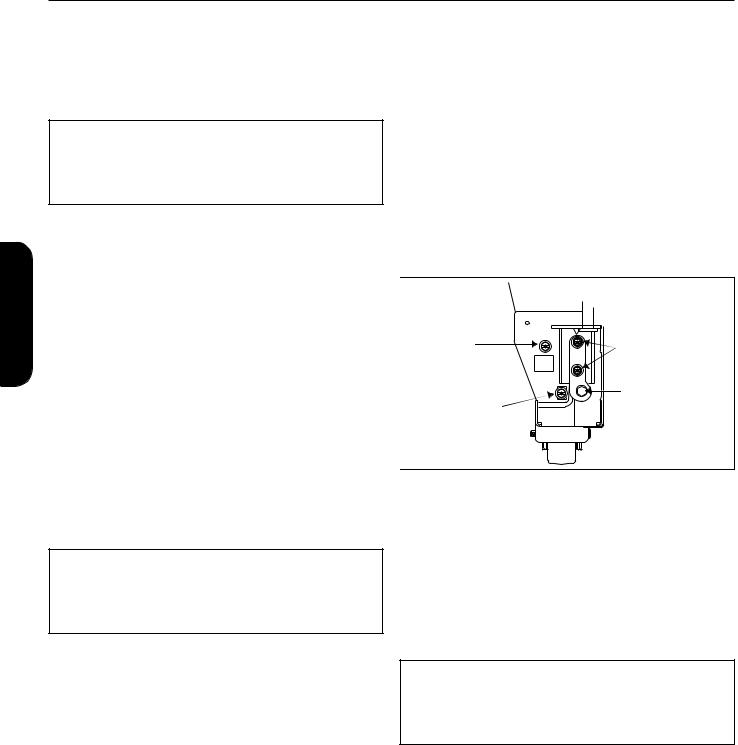
<![endif]>ENGLISH
Installation Instructions
Proper installation will ensure this refrigerator operates most efficiently.
Spacing Requirements
 WARNING: Keep flammable materials and vapors, such as gasoline away from refrigerator. Failure to do so can result in death, explosion, fire, or burns.
WARNING: Keep flammable materials and vapors, such as gasoline away from refrigerator. Failure to do so can result in death, explosion, fire, or burns.
•To ensure proper ventilation for your refrigerator, allow for a 1" (2.5 cm) space at the top and sides of your refrigerator.
•If your refrigerator has an ice maker, make sure you leave some extra space at the back to allow for the water line connection. The refrigerator can be flush with the back wall if you do not have an ice maker installed.
•If you are installing your refrigerator next to a fixed wall, leave 2 3/4" minimum on each side (depending on your model) to allow for the door to swing open 90°.
NOTE: Do not install the refrigerator near an oven, radiator, or other heat source, nor in a location where the temperature will fall below 55°F (13°C).
3.Place a level on top of refrigerator cabinet and level refrigerator.
•Refrigerator should be level from side to side. Place level on front and back edges of refrigerator cabinet to check side to side leveling. Adjust front and back adjustment screws as needed to level.
•Turn front roller adjustment screws to raise front of refrigerator 1/4" (6 mm), or 1/2 bubble on your level, higher than the back of your refrigerator.
4.If tops of doors are not aligned after leveling, loosen 3/8" refrigerator door hinge screws by 2 turns. Turn cam 1 increment at a time until doors are aligned. (Cam is turned clockwise to raise the door, counterclockwise to lower the door.) Open and close doors. Tighten hinge screws.
Rear roller |
3/8" refrigerator |
adjustment |
|
screw |
door hinge screws |
Front roller |
Hinge adjusting |
cam |
|
adjustment |
|
screw |
|
Leveling Refrigerator
 WARNING: Disconnect power to refrigerator before removing doors to avoid electrical shock which can cause severe personal injury or death. After replacing doors, connect power.
WARNING: Disconnect power to refrigerator before removing doors to avoid electrical shock which can cause severe personal injury or death. After replacing doors, connect power.
Some installations may require handle or door removal to get the refrigerator into the home. If so proceed to "Handle Removal" or "Door Removal" sections.
If your refrigerator requires ice maker water supply connection, proceed to "Connect Ice Maker Water Supply", section before leveling the refrigerator.
1.Remove toe grille.
2.Turn front and rear roller adjustment screws to raise or lower refrigerator cabinet until refrigerator is stable.
Removing Handles
Tools Required
Putty knife (blade covered by masking tape) 5/16" hex nut driver
3/8" hex nut driver Phillips screwdriver Blade screwdriver
 WARNING: Disconnect power to refrigerator before removing doors to avoid electrical shock which can cause severe personal injury or death. After replacing doors, connect power.
WARNING: Disconnect power to refrigerator before removing doors to avoid electrical shock which can cause severe personal injury or death. After replacing doors, connect power.
Some installations may require handle removal to get the refrigerator into the home. If so, perform the following steps:
4
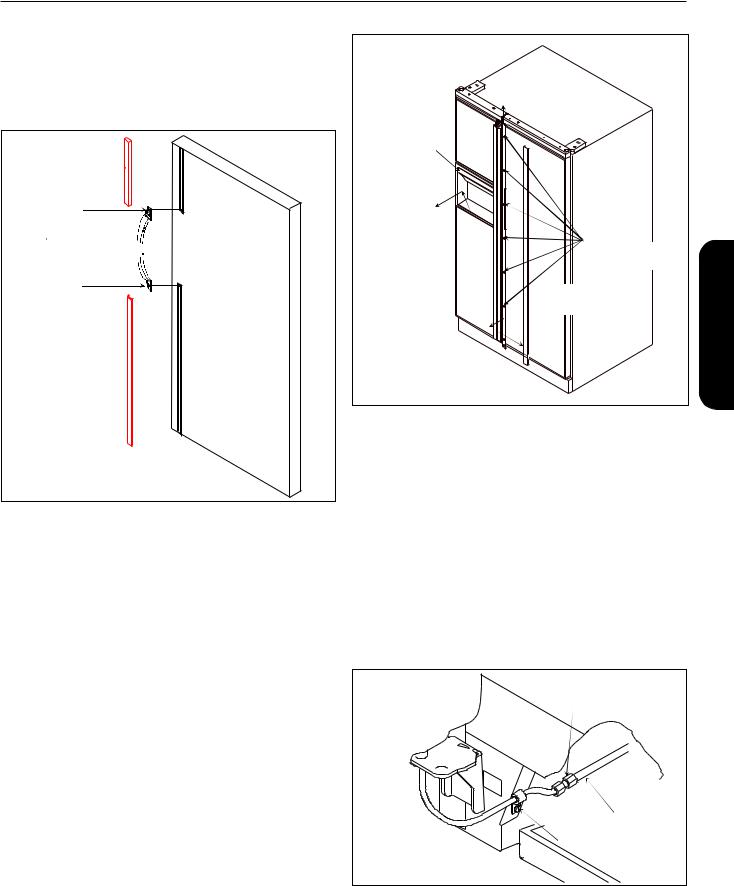
Models 57582, 57587, 57542, 57547
1.Pry up edge of handle trim using a putty knife, with the blade end covered in masking tape. Remove handle from door by removing 2 mounting screws at each end of handle.
Handle trim
Screw
Handle 



Screw
Handle trim
Handle

 cap
cap
Dispenser facade
6 hex head handle screws
 Handle
Handle
trim
4.Replace handle by performing steps 2–3 in reverse order. Replace handle trim by snapping back in place over handle trim.
2.To replace handle, mount handle to door with 2 mounting screws. Snap handle trim in place over ends of handle.
Models 57082, 57085, 57089
1.Pry up edge of handle trim by inserting screwdriver with the blade covered in masking tape, under top edge of handle trim and pry upward as you work your way down the handle. Remove handle cap from top of handle.
•Pry up bottom edge of dispenser facade on freezer door. Pull facade out of dispenser cavity before removing freezer door handle trim. (Dispenser units only.)
2.Remove 6 handle screws with 1/4" nut driver.
3.Remove handles from door.
Removing Doors
Some installations may require door removal to get the refrigerator into the home. If so, perform the following steps:
1.Remove toe grille.
2.Loosen water tube clamp screw. Loosen plastic water tube union nut. Pull water tube away from union nut and through tube clamp.
Plastic water tube union nut
Water tube
Water tube clamp screw
<![endif]>ENGLISH
5
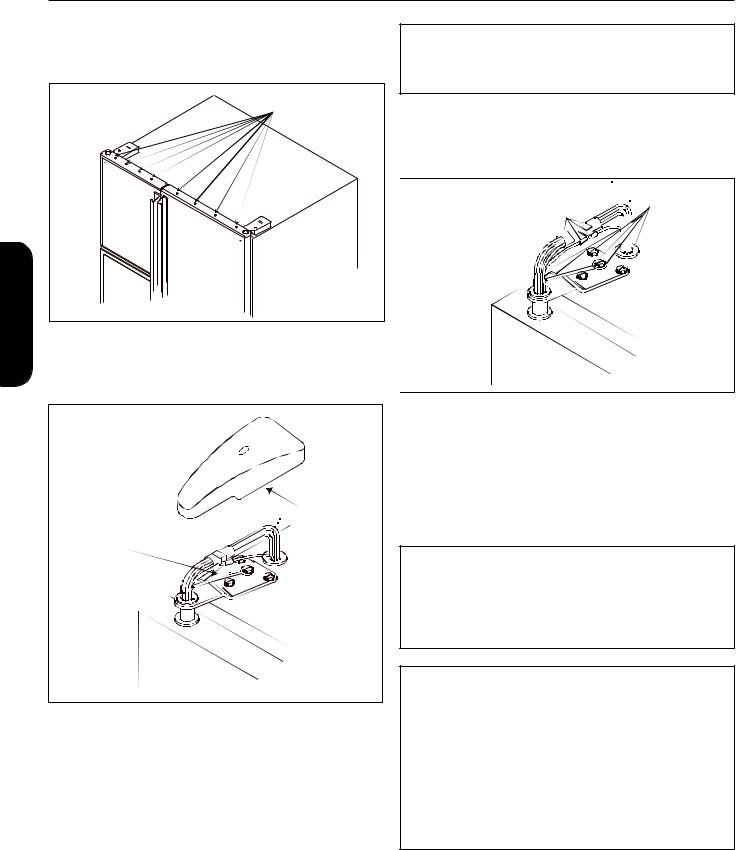
3.(Models 57082,57085, 57089 only) Remove 8 screws on freezer and refrigerator door top trim. Remove door trim.
Remove 8 top trim screws
 WARNING: To avoid electrical shock which can cause severe personal injury or death, green ground
WARNING: To avoid electrical shock which can cause severe personal injury or death, green ground
wire must remain attached to hinge.
5.Unplug top hinge wire connectors. Do not remove green ground wire from hinge (Freezer door only). Remove top hinge screws. Carefully lift and remove top hinges.
Freezer door only |
|
|
Top hinge |
||||
Wire connectors |
|
|
screws |
||||
|
|
|
|||||
|
|
|
|
|
|
|
|
|
|
|
|
|
|
|
|
|
|
|
|
|
|
|
|
<![endif]>ENGLISH
4.Remove top hinge cover. Models 57082, 57085, 57089, remove top hinge screw by removing hinge cover screw with a Phillips screwdriver.
 Green ground wire
Green ground wire
6.Carefully lift doors off bottom hinge.
7.Replace doors by performing steps 1–5 in reverse order.
Hinge cover
Top hinge
Connecting Water Supply
 WARNING: To avoid electrical shock which can cause severe personal injury or death,
WARNING: To avoid electrical shock which can cause severe personal injury or death,
disconnect power to refrigerator before connecting water supply. After connecting water supply, connect power.
 CAUTION: To avoid property damage, observe the following:
CAUTION: To avoid property damage, observe the following:
•Confirm water pressure to water valve is between 20 and 100 pounds per square inch.
•Tighten nut by hand to avoid cross threading. Finish tightening nuts with pliers and wrenches. Do not overtighten.
•Check for water leaks and correct if necessary before returning refrigerator to normal location and 24 hours after connecting.
6
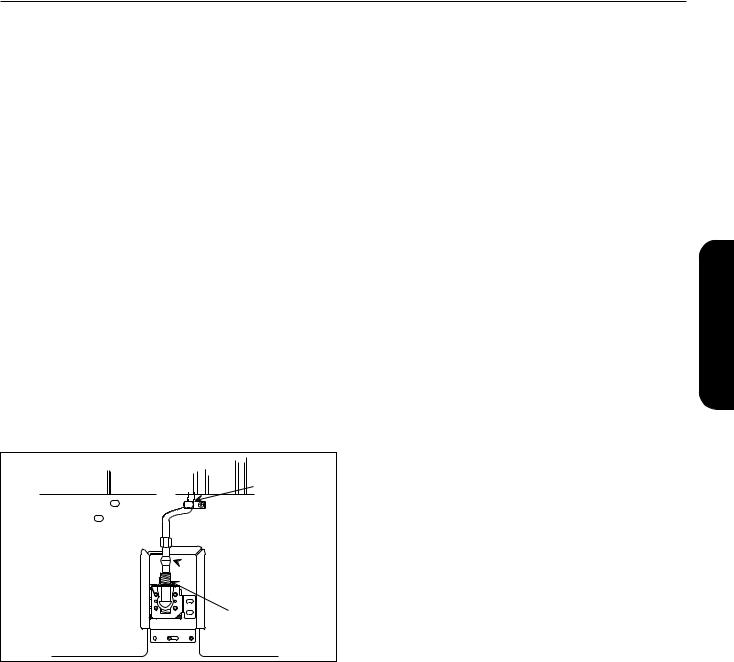
Important
•Before connecting water supply, contact a plumber to connect copper tubing to household plumbing in compliance with local codes and ordinances.
•A self-piercing or 3/16" saddle valve is not recommended. Both reduce water flow, can develop sediment build up, and may cause leaks if repair is attempted. The correct type of shut off valve requires a 1/4" hole to be drilled in water supply pipe prior to valve attachment.
•Do not use 1/4" OD plastic tubing.
•Do not run tubing from water supply in a location where the temperature may fall below 55° F.
Materials Required
1/4" (6 mm) flexible copper tubing. Length of copper tubing must reach from water supply connection plus an additional 8' (2 m) for service loop behind refrigerator.
Procedure
1.Remove plastic cap from water valve inlet port. Place brass nut and brass sleeve on copper tubing. Insert copper tubing into water valve inlet port. Handtighten brass nut on copper tubing to water valve inlet port. Use a wrench to finish tightening nut. Be careful not to overtighten nut. Confirm copper tubing is secure by pulling on copper tubing.
"P" clamp
Copper 
 Brass nut tubing
Brass nut tubing
 Brass sleeve
Brass sleeve
Water valve inlet connection
2.Create service loop using extreme care to avoid kinks. Secure copper tubing to refrigerator cabinet with a "P" clamp.
3.Turn on water supply to refrigerator and check for leaks. Correct any leaks.
4.Push refrigerator into opening. Recheck for leaks after 24 hours.
<![endif]>ENGLISH
7
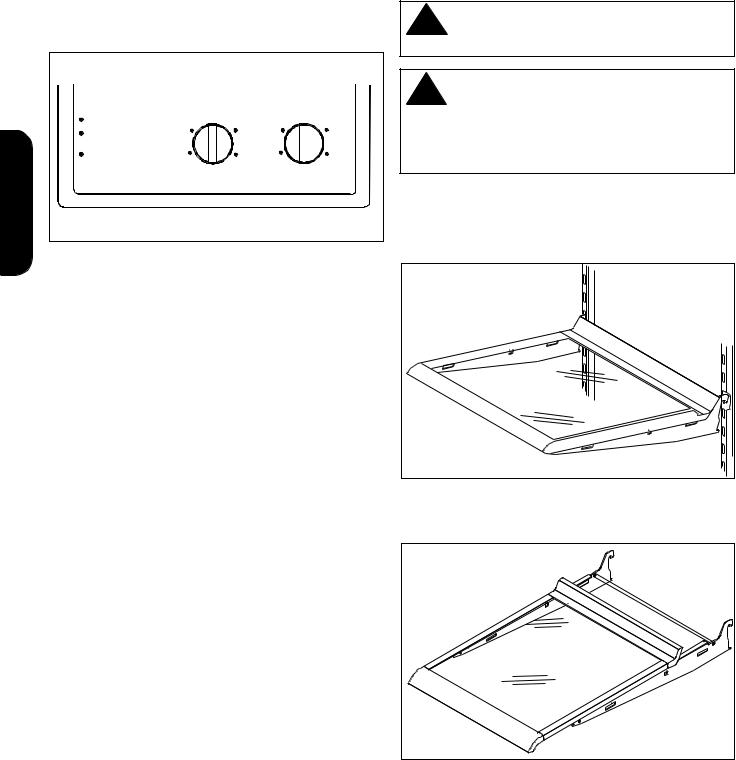
<![endif]>ENGLISH
Controls |
Fresh Food Features |
This refrigerator is designed to operate at normal household temperatures of 55° to 110°F (13° to 43°C).
Refrigerator and Freezer Controls
Refrigerator and freezer controls are located on upper rear wall of refrigerator section.
CONTROL DIRECTIONS |
FREEZER |
REFRIGERATOR |
||||||||
|
|
|
|
|
|
|
|
|
|
|
DASHES SHOW FACTORY |
3 |
|
|
|
4 |
3 |
|
|
|
4 |
SUGGESTED SETTINGS |
|
|
|
|
|
|
|
|
|
|
CHANGE ONE CONTROL AT |
|
|
|
|
|
|
|
|
|
|
A TIME. WAIT 24 HOURS |
2 |
|
|
|
5 |
2 |
|
|
|
5 |
BETWEEN ADJUSTMENTS. |
|
|
|
|
|
|||||
FREEZER ADJUSTMENT ALSO |
|
|
|
|
|
|
|
|
|
|
EFFECTS REFRIGERATOR |
1 |
|
|
|
6 |
1 |
|
|
|
6 |
TEMPERATURE |
|
|
|
|
|
|||||
|
|
|
||||||||
|
WARMEST |
OFF |
COLDEST |
WARMEST OFF COLDEST |
||||||
Fresh Food Shelves
Models feature either glass or wire shelves. Shelves adjust up or down to meet individual storage needs. Some models feature spill saving shelves. Spill saving shelves hold simple spills for easier cleaning.
!CAUTION: To avoid property damage, confirm shelf is secure before placing items on shelf.
!CAUTION: To avoid personal injury or property damage, handle tempered glass shelves
carefully. Shelves may break suddenly if nicked, scratched, or exposed to sudden temperature change.
•Remove shelves by lifting front, releasing hooks from metal track then pulling out.
•Replace shelves by inserting hooks into metal track and lowering front.
Setting Controls
When freezer control is set to OFF, neither refrigerator nor freezer sections will cool. Initially, set both controls to 4. Wait 24 hours for refrigerator and freezer sections to reach desired temperatures. After 24 hours, adjust controls, one number at a time, as desired. 1 is warmest setting and 6 is coldest.
Set controls with a household thermometer that includes temperatures between -5° and 50°F (-21° and 10°C).
Put thermometer snugly between frozen packages in freezer section. Wait 5–8 hours. If freezer temperature is not 0° to 2°F (-17° to -16°C), adjust freezer control, 1 number at a time. Check again after 5–8 hours.
Put thermometer in a glass of water in middle of refrigerator section. Wait 5–8 hours. If refrigerator temperature is not 38° to 40°F (3° to 4°C), adjust refrigerator control, 1 number at a time. Check again after 5–8 hours.
Slide out shelves pull forward for easy access of items in back.
8
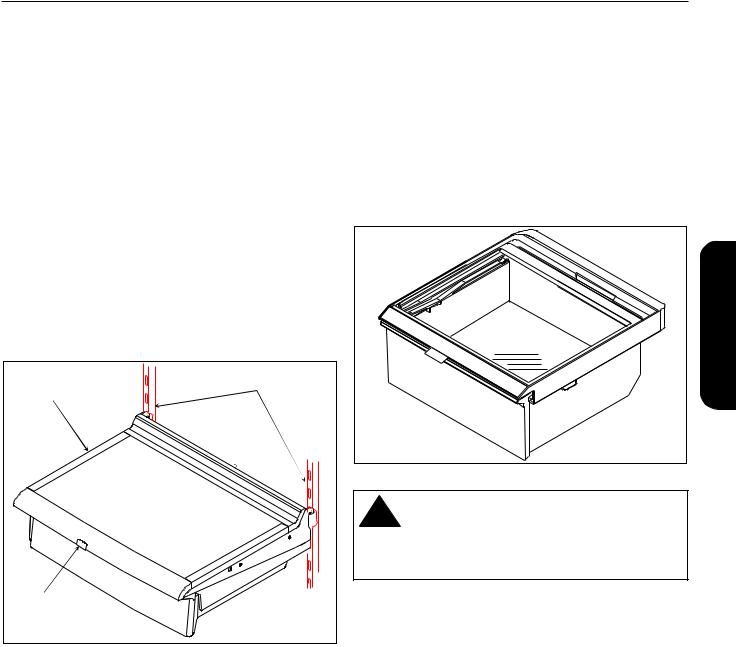
Temperature Controlled Meat Drawer
Temperature controlled meat drawer features a drawer inside a sleeve. Air circulates between drawer and sleeve. This systems keeps food fresh longer and up to 5°F (3°C) colder than refrigerator temperature.
Meat drawer control is located below front shelf trim. Control adjusts amount of air circulating around drawer. Slide control to COLD for normal refrigerator temperature and to COLDER for colder temperature. Ice crystals may form on drawer or food on COLDER setting. Cold air can decrease refrigerator temperature. Refrigerator control may need to be adjusted.
•Remove drawer by lifting and pulling out. Remove shelf by lifting front, releasing hooks from metal track then pulling out.
•Replace shelf by inserting hooks into metal track and lowering front. Use slots 8 through 11 only. Replace drawer by sliding in. Confirm boot is over air inlet in side wall.
Meat drawer boot
is on this side of Metal tracks drawer
Crisper Drawers
Crisper drawers keep produce fresh longer. Wrap produce tightly. Do not wash produce before placing in crispers. Excess moisture could cause produce to spoil prematurely. Do not line crispers with paper towels. Paper towels will retain moisture.
Crisper drawer controls are located below front shelf trim. Control adjusts humidity in crispers. Slide control to HIGH for produce with leaves such as lettuce, spinach or cabbage. Slide control to LOW for produce with skins such as cauliflower, corn or tomatoes.
LOWHumidity |
|
|
............................. |
||
|
Controlled |
Crispers |
|
|
HIGH |
<![endif]>ENGLISH
ColdTemperature |
|
|
.................. |
|
|
|
Controlled |
|
|
Colder |
Meats |
Control
! CAUTION: To avoid personal injury or property damage, handle tempered glass shelves carefully. Shelves may break suddenly if nicked, scratched, or exposed to sudden temperature change.
Remove shelf and crisper drawers by completing the following steps:
1.Open crisper.
2.Remove shelf by gently pushing up from underneath. Tilt one end up then pull out.
3.Remove crisper by lifting front while supporting underneath then pulling out.
4.Replace crispers and shelf by reversing steps 1–3.
9
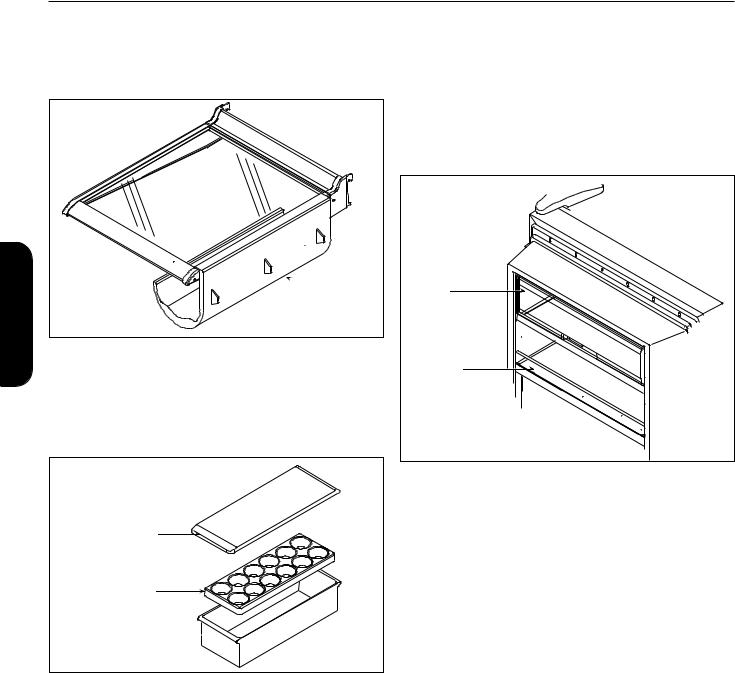
<![endif]>ENGLISH
Bottle Rack (some models) |
Dairy Center (Some models) |
Bottle rack provides convenient storage for a large bottle, |
Dairy center provides convenient storage for items such |
eggs, etc. |
as butter, cheese, etc. (see illustration below.) |
• Hang rack by hooking over side of shelf. |
|
 Bottle
Bottle
rack
Covered Storage Bucket (Some models)
Storage bucket has a lid and removable egg tray. When tray is removed, bucket will accept items such as a standard egg carton, ice, etc.
Lid
Egg tray
Storage bucket 
Snack Shelf (Some models)
Snack shelf provides convenient storage for small items and snacks. (See illustration below.)
Dairy center
Snack shelf
10

Temperature Controlled Beverage Cooler (Some models)
Temperature Controlled Beverage Cooler keeps beverages up to 5°F (3°C) colder than refrigerator section. Air inlet allows air from freezer section to pass to beverage cooler. Air inlet is located on interior wall of refrigerator door.
Beverage cooler control is located on left front wall of refrigerator section. Control adjusts amount of air circulating in beverage cooler. Turn control to COLD for normal refrigerator temperature and to COLDER for colder temperature.
Beverage cooler temperature control 

Colder
Beverage cooler
Beverage cooler air inlet
•Remove beverage cooler door by removing lower door buckets. Remove door buckets by pushing tabs toward center and pulling out. Slide door down and out through bottom of door track.
•Replace beverage cooler door by sliding door up through bottom of door track. Retention glides must remain in place to replace door. Replace door buckets by sliding in until tabs lock into place.
Beverage cooler door slides down to remove
Beverage cooler door
Remove shelf 
Door Shelves
•Remove slide-style door shelves by lifting ends up and pulling out.
•Replace slide-style door shelves by placing shelf on glides and sliding down.
!CAUTION: To avoid property damage, confirm shelf is secure before replacing items on shelf.
Shelf glide
Adjustable Divider (Some models)
Adjustable divider keeps items in place and adjusts to meet individual storage needs. Divider fits in any door bucket or door shelf.
Adjustable divider
<![endif]>ENGLISH
11

<![endif]>ENGLISH
Freezer Features
Automatic Ice Maker
•Confirm ice bucket is in place and ice maker arm is down.
















 Off
Off
position
Ice maker arm

 On
On
position
•After freezer section reaches normal temperature, ice maker fills with water and begins operating. Allow 24–48 hours after installation before first harvest of ice. Ice maker produces 7 to 9 harvests of ice in a 24–hour period under ideal conditions.
•After ice is formed, ice maker drops ice cubes into ice storage bucket. During ice production, ice maker arm raises and lowers. When ice storage bucket is full, ice maker arm turns ice maker off.
Note: Discard first 3 harvests of ice after initially connecting refrigerator to household water supply and after extended periods of non-use. This will prevent the consumption of any impurities left in the line or use of off-taste ice.
•If you wish to stop ice production raise ice maker arm. A definite click is heard when proper position is reached. Ice maker arm will remain in off position until pushed down.
!CAUTION: To avoid damage to ice maker, observe the following:
•Do not force ice maker arm down or up.
•Do not place or store anything in ice storage bucket.
Food Organizer Storage
Wire shelves and baskets slide out for easy access of items in back and can be rearranged to meet individual storage needs.
•Remove shelves and baskets by lifting front of shelf and pulling out.
•Replace shelves and baskets by placing shelves and baskets on side rails. Slide shelves and baskets right and back until round knob is behind stop on rail.
Wire shelf
Wire baskets
12
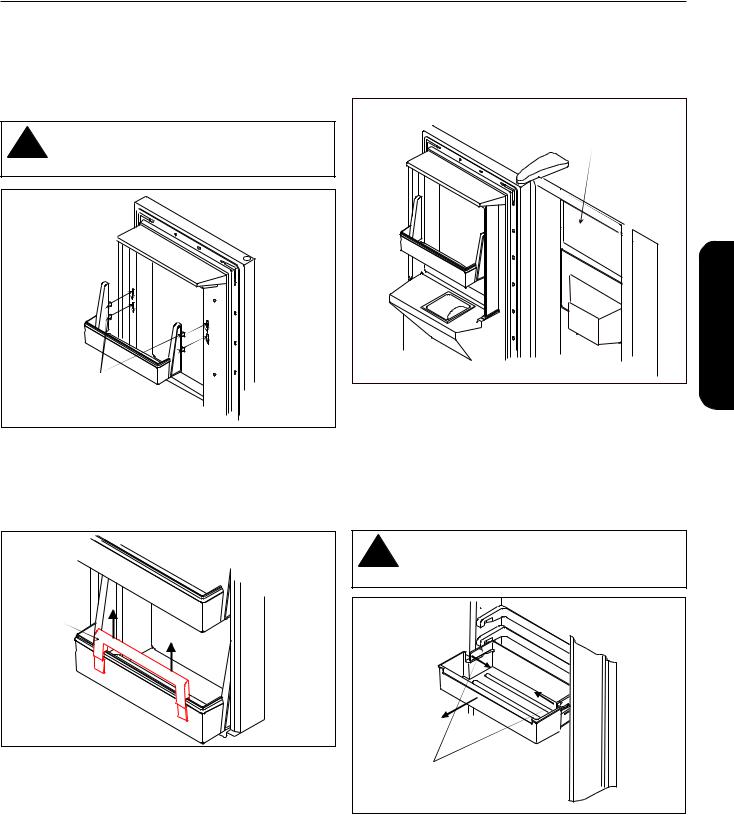
Door Shelves
•Remove hook-style door shelves by lifting ends and releasing hooks on bottom of shelf.
•Replace hook-style shelves by inserting hooks and lowering bottom of shelf. Push down on ends.
!CAUTION: To avoid property damage, confirm shelf is secure befor placing items on shelf.
Hooks
Tall Package Retainer (Some models)
Tall package retainer keeps tall items secure. Retainer fits in any door bucket or door shelf.
Tall package retainer
Ice Compartment
Ice compartment slides out for easy access to storage of ice trays or other frozen items.
Ice compartment cover
I |
|
ce |
Compartment |
|
<![endif]>ENGLISH
Door Buckets
Door buckets adjust to meet individual storage needs.
•Remove door buckets by pushing tabs toward center and pulling out.
•Replace door buckets by sliding in until tabs lock into place.
!CAUTION: To avoid property damage, confirm shelf is secure before placing items on shelf.
Tabs
13
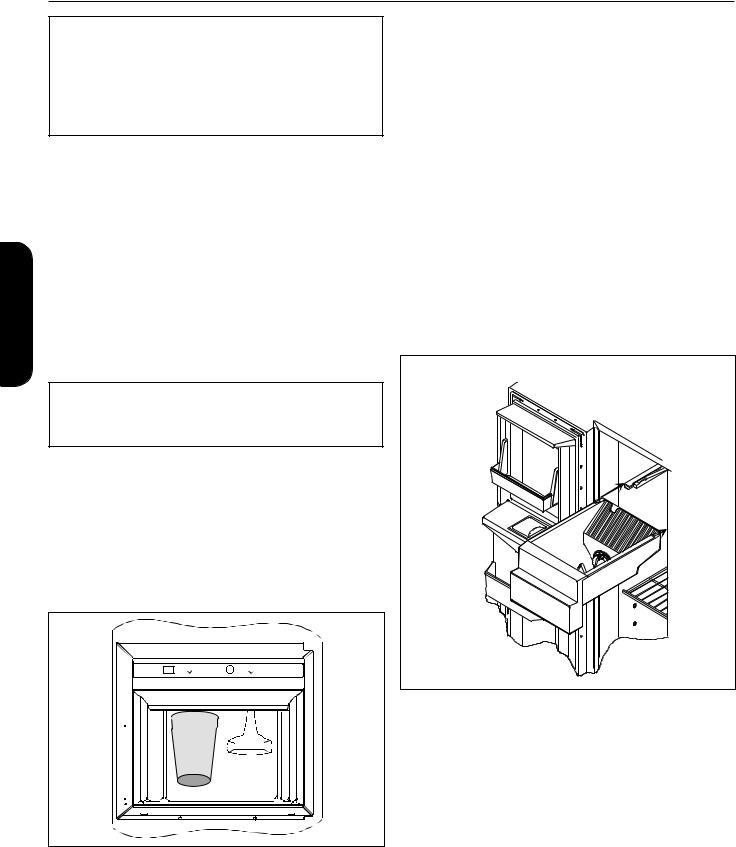
<![endif]>ENGLISH
Ice and Water Dispenser
 CAUTION: To avoid personal injury or property damage, the observe following instructions:
CAUTION: To avoid personal injury or property damage, the observe following instructions:
•Do not operate dispenser with freezer door open.
•Do not put fingers, hands, or any foreign object into dispenser opening.
•Do not use sharp objects to break ice.
Water Dispenser Operation
It takes approximately 1 minute after initially connecting refrigerator to household water supply before water dispenses. Discard first 10 to 14 containers of water after initially connecting refrigerator to household water supply and after extended periods of non-use.
•Dispense water by pressing sturdy wide-mouthed container against water dispenser bar.
•Stop water dispensing by releasing pressure on bar. A small amount of water may continue to fall. Spill shelf is not self-draining. Large spills should be wiped dry.
Ice Dispenser Operation
 CAUTION: To avoid personal injury or property damage, do not dispense ice directly into thin glass,
CAUTION: To avoid personal injury or property damage, do not dispense ice directly into thin glass,
fine china, or delicate crystal.
•Select cubed or crushed mode by sliding lever on dispenser panel. Dispense ice by pressing widemouthed container against ice dispenser bar.
Important:
Reduce spraying of crushed ice by holding widemouthed container directly under ice chute and as high as possible in dispenser area.
If large quantities of ice is desired, remove ice directly from the ice bin. If dispensing ice continuously, dispenser motor is designed to shut off after 3 to 5 minutes. Motor resets after 3 minutes and dispensing can continue.
A slight delay occurs when switching between cubed and crushed modes. Pieces of crushed ice will vary in size and shape. "Snow" may form on door and ice chute when repeatedly dispensing crushed ice. Allow "snow" to evaporate or wipe dry.
Note: Dispenser operates only with cubes of proper size and crescent shape. Do not add purchased ice cubes or other shaped cubes to ice bucket.
Removing Ice Bucket
•Remove ice bucket by lifting bucket and pulling out.
•Replace ice bucket by sliding in until bucket locks in place. Ice bucket must be locked in place for proper ice dispensing. If freezer door does not close, bucket is not in proper location.
ICE |
WATER |
CUBED CRUSHED
14
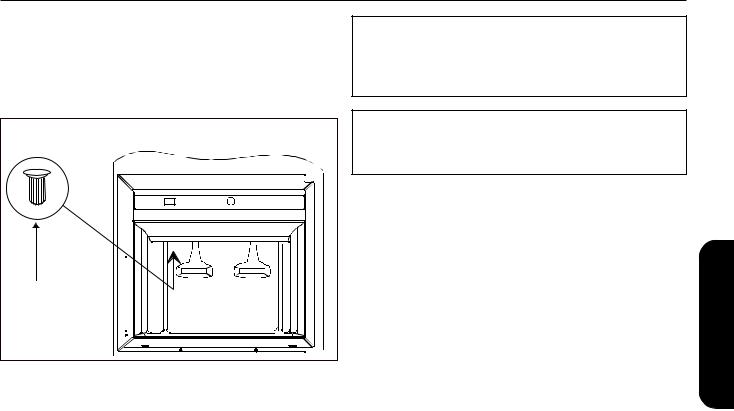
Care and Cleaning
Dispenser Light (Some models)
A light is activated when dispensing ice or water. Some models feature a night light.
•Deactivate night light by pushing switch, located underneath dispenser and left of ice dispenser bar.
Night light switch
Taste and Odor
Observe the following to minimize taste and odor difficulties:
•Discard first 3 harvests of ice after initially connecting refrigerator to household water supply and after extended periods of non-use. This will prevent the consumption of any impurities left in the line or use of off-taste ice.
•Wrap foods in tightly sealed containers or moisture proof bags.
•Install water filter on water line.
•Contact local water treatment company for specialized help if difficulties persist.
•Discard ice if left unused for an extended period.
 WARNING: To avoid electrical shock which can cause severe personal injury or death, disconnect power to refrigerator before cleaning. After cleaning, connect power.
WARNING: To avoid electrical shock which can cause severe personal injury or death, disconnect power to refrigerator before cleaning. After cleaning, connect power.
 CAUTION: To avoid personal injury or property damage, read and follow all cleaning product manufacturer's directions.
CAUTION: To avoid personal injury or property damage, read and follow all cleaning product manufacturer's directions.
General Cleaning
1.Wash interior and exterior surfaces with 4 tablespoons baking soda dissolved in 1 quart warm water and a soft, clean cloth.
2.Rinse surfaces with warm water. Dry surfaces with a soft, clean cloth.
•Do not use the following items:
-abrasive or harsh cleaners, ammonia, chlorine bleach, etc.
-concentrated detergents or solvents
-metal scouring pads
These items can scratch, crack and discolor surfaces.
•Do not place buckets, shelves, etc. in dishwasher.
Adhesives
1.Remove glue residue by rubbing toothpaste into adhesive with fingers until adhesive loosens.
2.Rinse surface with warm water. Dry surface with a soft, clean cloth.
Door Gaskets
1.Clean door gaskets every 3 months according to “General Cleaning” instructions above. Clean any spills immediately.
2.Apply a light film of petroleum jelly to keep gaskets pliable.
Condenser Coils
Clean condenser coil every 3 months to ensure maximum performance of refrigerator. Accumulated dust and lint may cause the following:
•reduced cooling performance
•increased energy usage
•premature compressor failure
1.Remove lower front toe grille by holding ends and pulling forward.
2.Clean front surface of condenser coil with a vacuum cleaner hose nozzle.
3.Replace toe grille by inserting clips in holes and snapping in.
<![endif]>ENGLISH
15
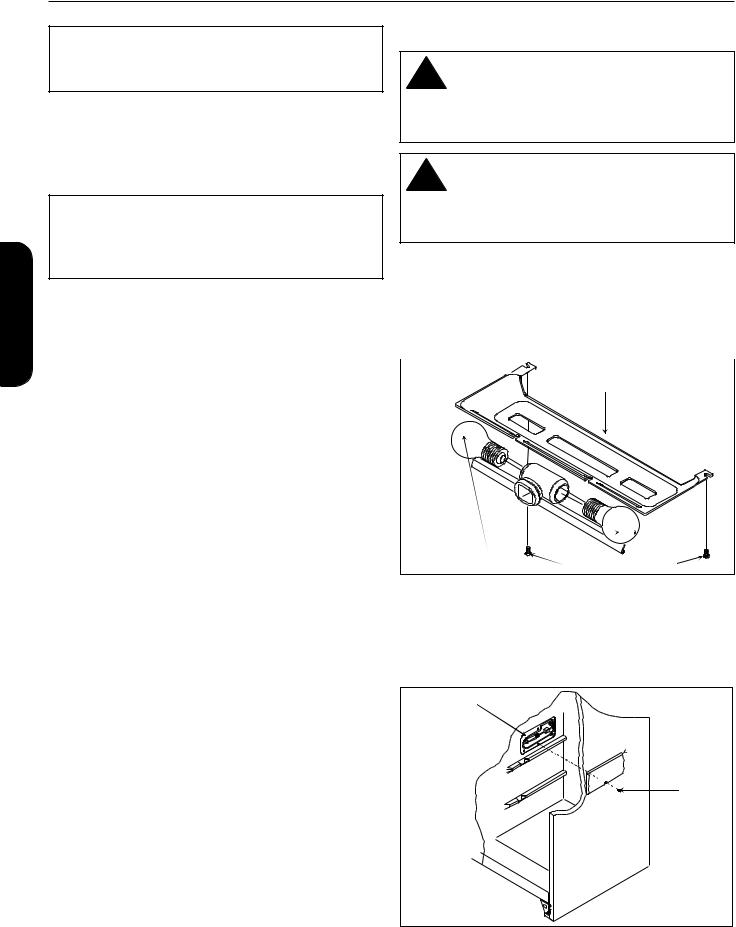
<![endif]>ENGLISH
 CAUTION: To avoid property damage, protect soft vinyl or other flooring with cardboard, rugs, or other protective material.
CAUTION: To avoid property damage, protect soft vinyl or other flooring with cardboard, rugs, or other protective material.
4.Pull refrigerator away from wall. Run a vacuum brush across condenser fan outlet grille on back of refrigerator.
Glass Shelves
 CAUTION: To avoid personal injury or property damage, handle tempered glass shelves carefully. Shelves may break suddenly if nicked, scratched, or exposed to sudden temperature change.
CAUTION: To avoid personal injury or property damage, handle tempered glass shelves carefully. Shelves may break suddenly if nicked, scratched, or exposed to sudden temperature change.
Remove shelf by lifting front, releasing hooks from metal track then pulling out. Place shelf on a towel. Allow shelf to adjust to room temperature before cleaning.
Clean crevices by completing the following steps:
1.Dilute mild detergent and brush solution into crevices using a plastic bristle brush. Let set for 5 minutes.
2.Spray warm water into crevices using faucet spray attachment.
3.Dry shelf thoroughly and replace shelf by inserting hooks into metal track and lowering front.
Odor Removal
1.Remove all food and disconnect power to refrigerator.
2.Clean all interior surfaces including ceiling, floor, and walls according to “General Cleaning” instructions. Pay special attention to corners, crevices, and grooves. Include all drawers, shelves, and gaskets.
3.Connect power to refrigerator and return food to refrigerator. Wash and dry all bottles, containers and jars. Wrap foods in tightly sealed containers to prevent further odor. After 24 hours, check if odor was eliminated.
Complete the following steps if odor was not eliminated.
4.Place garden fresh crispers on top shelf of Fresh Food section. Pack Fresh Food and Freezer sections including doors with crumpled sheets of black and white newspaper.
5.Place charcoal briquettes randomly throughout newspaper.
6.Close doors and let stand 24–48 hours.
7.Remove charcoal briquettes and newspapers.
8.Complete steps 2–3.
Contact Sears service center if odor was still not eliminated. Refer to service section for phone number.
Light Bulb Replacement
! WARNING: To avoid electrical shock which can cause severe personal injury or death, disconnect power to refrigerator before replacing light bulb. After replacing light bulb, connect power.
! CAUTION: To avoid personal injury or property damage, observe the following:
•Allow light bulb to cool.
•Wear gloves when replacing light bulb.
Upper Fresh Food Section
•Remove light bulb cover by removing ¼" hex nut screws. Replace bulb(s) with 40-watt appliance bulb(s).
•Replace light bulb cover by replacing ¼" hex nut screws.
Light bulb cover
Light bulbs |
1/4" hex not screws |
Lower Fresh Food Section (Some models)
•Remove light bulb cover by removing screw. Replace bulb with 40-watt tubular bulb.
•Replace light bulb cover by placing cover over light bulb. Insert and tighten screw.
Light bulb
Light bulb cover
Screw
16
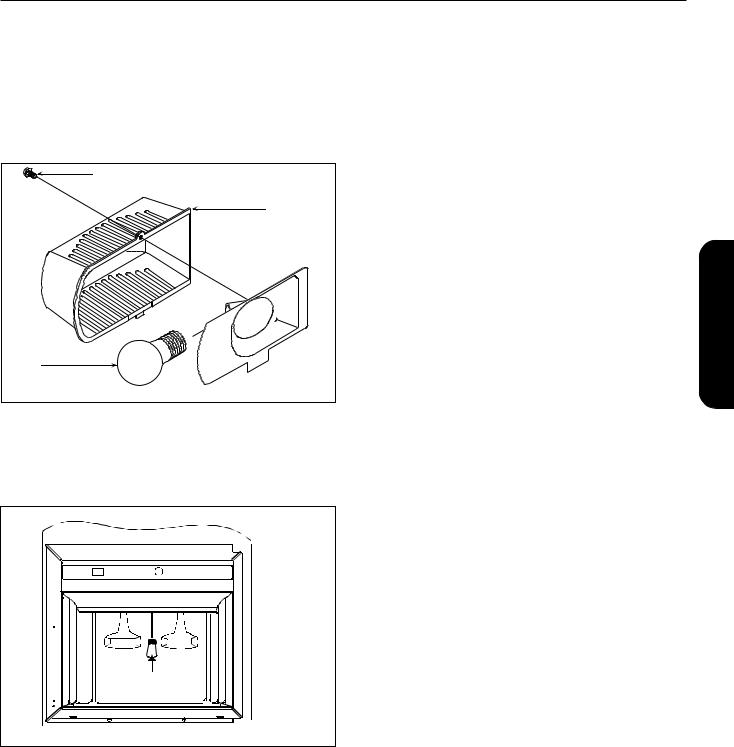
Energy Tips
Freezer Section
1.Remove ice bucket by lifting bucket and pulling out.
2.Remove light bulb cover by removing 1/4" hex nut screw. Replace bulb with 40-watt appliance bulb.
3.Replace light bulb cover by holding cover in place over light bulb. Insert and tighten screw.
4.Replace ice bucket by sliding in until bucket locks in place.
Screw
Light bulb cover
This refrigerator is designed to be one of the most energy efficient refrigerators available. Reduce energy use by observing the following.
•Operate in normal household temperatures of 55° to 110°F (13° to 43°C) away from heat sources and direct sunlight.
•Set refrigerator, freezer, and temperature controlled meat drawer controls no colder than necessary.
•Keep freezer section full.
•Keep door gaskets clean and pliable. Replace gaskets if worn.
•Keep condenser coils clean.
Light bulb
Ice ‘N’ Water™ Dispenser (Some models)
Light bulb is located between dispenser arms.
•Remove light bulb by unscrewing light bulb. Replace light bulb with a 6-watt, 120-volt bulb.
•Replace light bulb by inserting and tightening bulb.
Vacation Tips
Complete the following steps for short vacations.
1.Remove perishable foods.
2.If an ice maker is installed, move ice maker arm up, to Off position. (See Automatic Ice Maker Instructions page 12)
Complete the following steps for long vacations.
1.Empty refrigerator and freezer sections.
2.Unplug refrigerator.
3.Clean refrigerator and door gaskets according to “General” instructions in “Care and Cleaning” section.
4.Prop doors open, so air can circulate inside.
5.If an ice maker is installed, turn water supply to refrigerator off and move ice maker arm up, to Off position.
Ice ‘N’ Water
Dispenser
Light bulb
<![endif]>ENGLISH
17
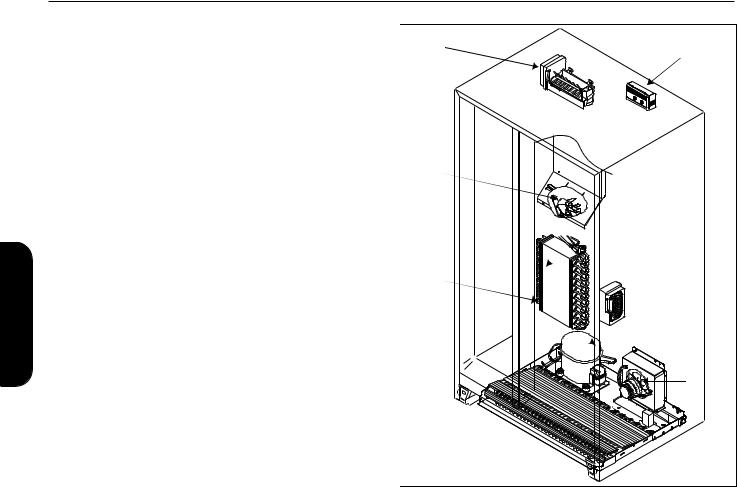
<![endif]>ENGLISH
Normal Operating Sounds
This new refrigerator may be replacing a differently designed, less efficient or smaller refrigerator. Today’s refrigerators have new features and are more energy efficient. As a result, certain sounds may be unfamiliar. These sounds are normal and will soon become familiar. These sounds also indicate refrigerator is operating and performing as designed.
1.Freezer control clicks when starting or stopping compressor.
2.Freezer fan air rushes and whirs.
3.Sealed system (evaporator and heat exchanger) refrigerant flow gurgles, pops or sounds like boiling water.
4.Defrost heater sizzles, hisses or pops.
5.Condenser fan air rushes and whirs.
6.Compressor has a high pitched hum or pulsating sound that cycles on and off.
7.Ice cubes from ice maker (some models) drop into ice bucket.
Ice auger motor (Ice and water dispenser models) hums as auger agitates ice during dispensing. Ice auger motor is located behind ice bucket in freezer section. (Not shown)
Ice maker water valve hookup (some models) buzzes when ice maker fills with water. This occurs whether or not refrigerator is connected to water supply. If refrigerator is not connected to water supply, stop sound by raising ice maker arm to off position. Water valve hook up is located in back, bottom, left hand corner.
(Not shown)
Foam insulation is very energy efficient and has excellent insulating capabilities. However, foam insulation is not as sound absorbent as previously used fiberglass insulation. (Not shown)
7
1
2
3 
4
6
5
18

Refrigerator Troubleshooting Guide
The refrigerator will not operate |
|
Check if... |
Then... |
The power supply cord is unplugged. |
Firmly plug the cord into a live outlet with proper |
|
voltage. |
A household fuse has blown or circuit breaker tripped. |
Replace the fuse or reset the circuit. |
The freezer control is set to OFF. |
Set freezer control to a mid-range setting. |
The refrigerator is in a defrost cycle. |
Wait 40 minutes to see if refrigerator restarts. If freezer |
|
control is on, lights work, but 2 fans and compressor |
|
are not operating, refrigerator may be in defrost cycle. |
If refrigerator still will not operate, unplug refrigerator. Transfer food to another refrigerator or place dry ice in freezer section to preserve food. Call for service.
The lights do not work
Check if... |
Then... |
The power supply cord is unplugged. |
Firmly plug the cord into a live outlet with the proper |
|
voltage. |
A light bulb is loose in the socket. |
Gently remove the bulb and reinsert. |
A light bulb has burned out. |
Replace with an appliance bulb of the same wattage, |
|
size and shape available at your local hardware store. |
|
Turn the refrigerator control to OFF and unplug the |
|
refrigerator prior to replacement. |
The refrigerator is making unfamiliar noises or the compressor seems to run too much
Check if... |
Then... |
The refrigerator is making an unfamiliar noise. |
See “Normal Operating Sounds” section. |
The condenser coils are dirty. |
See “Cleaning Condenser Coils” instructions of “Care |
|
and Cleaning” section. |
The room temperature is hotter than normal. |
The motor will run longer under warm conditions. Expect |
|
the motor to run about 40% to 80% of the time at normal |
|
room temperatures and even more at higher |
|
temperatures. |
The door is opened often or a large amount of food |
Adding food and opening the door warms the |
has just been added. |
refrigerator. It is normal for the refrigerator to run longer |
|
in order to cool the refrigerator back down. |
The doors are not closed completely or are misaligned. |
See “Leveling” instructions in “Installation Instructions” |
|
section. |
The base grille is blocked. |
This prevents air circulation. Remove lower front grill |
|
and check for obstructions. |
The freezer control is set too low. |
See “Setting Controls” instructions of “Controls” section. |
Gaskets are sealing against refrigerator cabinet. |
If gaskets are not sealing properly see “Leveling and |
|
Alignment” instructions of “Installation Instructions” |
|
section. |
Doors will not close completely or are misaligned
Check if... |
Then... |
The refrigerator is not level. |
Level refrigerator front-to-back and side-to-side. Shim(s) |
|
may be required under a rear roller if the floor is uneven. |
|
It is VERY IMPORTANT for your refrigerator to be level |
|
in order to function properly. |
Food packages are blocking the door open. |
Rearrange food containers to clear door and door |
|
shelves. |
The ice bin, shelves, door bins, or crispers are out of |
Push bins all the way in and put crispers and shelves |
position. |
into their correct positions. |
<![endif]>ENGLISH
19

Refrigerator Troubleshooting Guide
Temperature is too warm or there is moisture build-up
|
Check if... |
Then... |
|
|
The air vents are blocked. Cold air circulates from the |
Locate air vents by using your hand to sense airflow |
|
|
freezer to the fresh food section and back again |
and move all packages that block vents and restrict |
|
|
through air vents in the wall dividing the two sections. |
airflow. |
|
|
The doors are opened often. |
When the door is opened, warm humid air is allowed |
|
|
|
|
into the refrigerator. The more the door is opened, the |
|
|
|
faster the humidity builds up, and the more warm air the |
|
|
|
refrigerator must cool. |
|
The light stays on when the doors are closed. |
If lights are staying on call for service. |
|
|
The refrigerator or freezer controls are not set properly. |
See “Setting Controls” instructions of “Controls” section. |
|
|
A large amount of food has just been added to the |
Adding food warms the refrigerator. It can take a few |
|
|
refrigerator or freezer. |
hours for the refrigerator to return to normal |
|
|
|
|
temperature. |
|
The food is not packaged correctly. |
Wrap food tightly and wipe off damp containers prior to |
|
| <![if ! IE]> <![endif]>ENGLISH |
Water droplets form on inside of refrigerator. |
storing in the refrigerator to avoid moisture |
|
This is considered normal during high humidity periods |
|||
|
|
|
accumulation. |
|
The door is misaligned or not closing completely. |
See “Doors will not close completely or are |
|
|
|
|
“misaligned”. |
|
|
|
or if doors have been opened frequently. |
|
Water droplets or frost forming on beverage chiller |
It is normal during high humidity periods or if doors |
|
|
control. |
have been opened frequently. Reduce water droplets or |
|
|
|
|
frost by turning control counterclockwise. |
|
Water droplets or frost forming on temperature |
It is normal during high humidity periods or if doors |
|
|
controlled meat drawer. |
have been opened frequently. Reduce water droplets or |
|
|
|
|
frost by sliding temperature controlled meat drawer to |
|
|
|
the left. |
|
Water droplets form on outside of refrigerator. |
Check door gaskets for proper seal. |
|
|
The temperature controlled meat drawer is too warm |
||
|
Check if... |
Then... |
|
|
Temperature control on drawer is set cold enough. |
See “Temperature Controlled Meat Drawer” |
|
|
|
|
instructions in “Refrigerator Features”Section. |
|
Freezer temperature is set cold enough. |
See “Setting Controls” instructions of “Controls” |
|
|
|
|
section. |
|
The food temperature is too cold |
|
|
|
Check if... |
Then... |
|
|
The condenser coil requires cleaning. |
|
See “Condenser Coil” instructions in “Care and |
|
|
|
Cleaning” section. |
|
Refrigerator and freezer controls are properly |
|
See “Setting Controls” instructions of “Controls” section. |
|
adjusted. |
|
Allow several hours for temperature to adjust. |
|
Temperature controlled meat drawer or crisper drawer does not close freely |
||
|
Check if... |
Then... |
|
|
A package that may prevent drawer from closing |
Rearrange contents of drawer to allow drawer to close. |
|
|
properly. |
|
|
|
Drawer is in proper position. |
See “Temperature Controlled Meat Drawer” or Crisper |
|
|
|
|
Drawer” instructions of “Refrigerator Features” |
|
|
|
section. |
|
Drawer channels are dirty. |
Clean drawer channels with warm, soapy water. Rinse |
|
|
|
|
thoroughly and dry. |
|
Drawer channels have lubrication. |
Apply a thin layer of petroleum jelly to drawer |
|
|
|
|
channels. |
20

Refrigerator Troubleshooting Guide
The ice dispenser will not operate properly
Check if... |
Then... |
The freezer door is not closed completely. |
Push door firmly shut. If door will not close fully see |
|
“Doors will not close completely or are misaligned.” |
There is no ice in the bucket. |
See “The ice maker is not producing ice.” |
The wrong ice has been added to the bin. |
Use only cubes produced by the current ice maker. |
|
Remove all other cubes and check to make sure none |
|
have become stuck in the delivery chute. |
The ice has frozen in the bin. |
Shake the bin to separate cubes or discard cubes and |
|
wait 24 hours for ice to restock. |
Ice is stuck in the delivery chute. |
Clear the ice from the delivery chute with a plastic |
|
utensil. Do not use anything sharp to remove the ice or |
|
damage could occur. |
The ice bin is not installed correctly. |
Push the ice bin in fully and check to make sure it is |
|
installed correctly. See “Automatic Ice Maker” |
|
instructions of “Freezer Features” section. |
The dispenser water is not cool enough
Check if... |
Then... |
The refrigerator has been newly installed. |
Allow 24 hours for the tank to cool completely. |
A large amount of water has been recently dispensed |
Allow 24 hours for the tank to cool completely. |
No water has been recently dispensed. |
The first glass of water may not be cool. Discard the |
|
first glass. |
The water dispenser will not operate properly
Check if... |
Then... |
The freezer door is not closed completely |
Push door firmly shut. If door will not close fully see |
|
“Doors will not close completely or are misaligned.” |
The water tank has not filled. |
Depress water dispenser lever or pad until 2 to 3 |
|
quarts of water have been removed. It may take a few |
|
minutes for water to begin to dispense. Discard water. |
The water supply shut-off valve to the refrigerator is not |
Check the water supply hookup in your house and turn |
turned on. |
on the water valve if necessary. |
A water filter has been installed on the water line |
Check for filter clogs or improper installation of the |
outside the refrigerator. |
filter. |
The water supply is incorrectly installed or not |
See “Connecting Water Supply” section of “Installation |
connected. |
Instructions” or label on back of refrigerator for water |
|
supply hook up instructions. Use only copper tubing. |
|
Do not use piercing type valves. |
Plastic hose was used for hookup, may be kinked. |
Replace with copper tubing which is more durable and |
|
resistant to kinking. |
|
|
Copper tubing may be kinked. |
Replace tubing that is damaged. |
Water or ice is leaking from the dispenser
Check if... |
Then... |
The glass is not being held under the dispenser long |
Hold the glass under the dispenser for 2 to 3 seconds |
enough, causing ice to spill and water to drip. |
after releasing the lever or pad. A small amount of |
|
water or ice may continue to dispense during this time. |
An ice cube is stuck in the delivery chute and is holding |
Remove the cube from the chute. |
the trap door open. |
|
<![endif]>ENGLISH
21

Refrigerator Troubleshooting Guide
The ice maker is not producing ice
|
Check if... |
Then... |
||
|
The ice maker arm is up, in the OFF position. |
Lower arm to ON position. |
||
|
The freezer is not cold enough to produce ice. |
Allow 24 hours after the refrigerator is installed for the |
||
|
|
icemaker to begin producing ice. |
||
|
The water supply shut-off valve to the refrigerator is not |
Check the water supply hookup in your house and turn |
||
|
turned on. |
on the water valve if necessary. |
||
|
The water filter has been installed on the water line |
Check for filter clogs or improper installation if the |
||
|
outside the refrigerator. |
filter. |
||
|
The ice maker mold has no water in it or no ice has |
The water supply is incorrectly installed or not |
||
|
been produced. |
connected. See “Connecting Water Supply” section of |
||
|
|
“Installation Instructions”. Use only copper tubing. Do |
||
|
|
not use piercing type valves. |
||
|
A plastic hose was used for hookup which may be |
Replace with copper tubing which is more durable and |
||
| <![if ! IE]> <![endif]>ENGLISH |
kinked. |
resistant to kinking. |
||
The water pressure seems too low or too high. |
The ice maker needs to be connected to a cold water |
|||
|
||||
|
|
line with water pressure of 20-120 psi to function |
||
|
|
properly. |
||
|
The ice maker is not producing enough ice |
|
|
|
|
Check if... |
Then... |
||
|
The ice maker has just been installed or a large amount |
Wait 24 hours for ice production to begin and for ice |
||
|
of ice has just been used. |
maker to restock after emptied. |
||
|
The controls are set properly. The freezer must be cold |
Start at mid-range settings for both freezer and |
||
|
enough to produce ice. |
refrigerator and adjust as needed. See “Setting |
||
|
|
Controls” section of Controls. |
||
|
The water supply shut-off valve to the refrigerator is not |
Check the water supply hookup in you house and turn |
||
|
fully turned on. |
the water valve on fully. |
||
|
Self piercing type or 3/16” saddle valve was used for |
Replace with correct type of saddle valve requiring ¼" |
||
|
hookup. Both reduce water flow and may become |
hole to be drilled in water supply pipe before valve |
||
|
clogged over time. |
attachment. |
||
|
Plastic hose was used for hookup, may be kinked or |
Replace with copper tubing which is more durable and |
||
|
leaking. |
resistant to kinking. |
||
|
Ice has off-taste or odor |
|
|
|
|
Check if... |
Then... |
||
|
Icemaker was recently installed. |
Discard first few batches of ice to avoid discolored or |
|
|
|
|
off-flavored ice. |
|
|
|
Ice has been stored too long. |
Throw away old ice and make new supply. |
|
|
|
Food has not been wrapped tightly in either |
Rewrap foods since odors may migrate to the ice if |
|
|
|
compartment. |
food is not wrapped properly. |
|
|
|
Water supply contains minerals such as sulfur. |
A filter may need to be installed to eliminate taste and |
|
|
|
|
odor problems. |
|
|
22
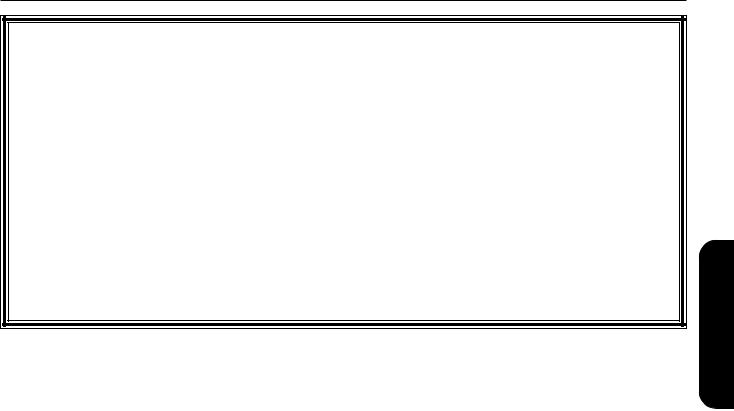
Warranty
Full One Year Warranty on Refrigerator
For one year from the date of purchase, when this refrigerator is operated and maintained according to instructions attached to or furnished with it, Sears will repair it, free of charge, if defective in material or workmanship.
Full Five Year Warranty on Sealed Refrigeration System
For five years from the date of purchase, when this refrigerator is operated and maintained according to instructions attached to or furnished with it, Sears will repair the sealed system (consisting of refrigerator, connecting tubing and compressor motor) free of charge, if defective in material or workmanship.
The above warranty coverage applies only to refrigerators which are used for storage of food for private household purposes.
Warranty service is available by contacting 1-800-4-REPAIR (473-7247).
This warranty applies only while this product is in use in the United States.
This warranty gives you specific legal rights, and you may also have other rights, which vary from state to state.
Sears, Roebuck and Co, Dept 817WA, Hoffman Estates, IL 60179
Read and Save These Instructions
Record in the space provided below, the model and serial numbers found on the serial plate located on the top left wall of the refrigerator compartment.
Model Numer: __________________________________
Serial Number: _________________________________
Purchase Date: _________________________________
<![endif]>ENGLISH
23
